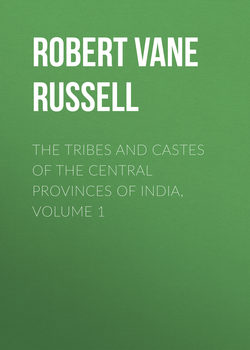Читать книгу The Tribes and Castes of the Central Provinces of India, Volume 1 - Robert Vane Russell - Страница 56
Part I.
Introductory Essay on Caste
Introductory Essay on Caste
53. The distribution of life over the body
ОглавлениеPrimitive man further thought that life, instead of being concentrated in certain organs, was distributed equally over the whole of the body. This mistake appears also to have been natural and inevitable when it is remembered that he had no name for the body, the different limbs and the internal organs, and no conception of their existence and distribution, nor of the functions which they severally performed. He perceived that sensation extended over all parts of the body, and that when any part was hurt or wounded the blood flowed and life gradually declined in vigour and ebbed away. For this reason the blood was subsequently often identified with the life. During the progress of culture many divergent views have been held about the source and location of life and mental and physical qualities, and the correct one that life is centred in the heart and brain, and that the brain is the seat of intelligence and mental qualities has only recently been arrived at. We still talk about people being hard-hearted, kind-hearted and heartless, and about a man’s heart being in the right place, as if we supposed that the qualities of kindness and courage were located in the heart, and determined by the physical constitution and location of the heart. The reason for this is perhaps that the soul was held to be the source of mental qualities, and to be somewhere in the centre of the body, and hence the heart came to be identified with it. As shown by Sir J.G. Frazer in The Golden Bough many peoples or races have thought that the life and qualities were centred in the whole head, not merely in the brain. And this is the reason why Hindus will not appear abroad with the head bare, why it is a deadly insult to knock off a man’s turban, and why turbans or other head-gear were often exchanged as a solemn pledge of friendship. The superstition against walking under a ladder may have originally been based on some idea of its being derogatory or dangerous to the head, though not, of course, from the fear of being struck by a falling brick. Similarly, as shown in the article on Nai, the belief that the bodily strength and vigour were located in the hair, and to a less extent in the nails and teeth, has had a world-wide prevalence. But this cannot have been primary, because the hair had first to be conceived of apart from the rest of the body, and a separate name devised for it, before the belief that the hair was the source of strength could gradually come into existence. The evolution of these ideas may have extended over thousands of years. The expression ‘white-livered,’ again, seems to indicate that the quality of courage was once held to be located in the liver, and the belief that the liver was the seat of life was perhaps held by the Gonds. But the primary idea seems necessarily to have been that the life was equally distributed all over the body. And since, as will be seen subsequently, the savage was incapable of conceiving the abstract idea of life, he thought of it in a concrete form as part of the substance of the flesh and blood.
And since primitive man had no conception of inanimate matter it followed that when any part of the body was severed from the whole, he did not think of the separate fraction as merely lifeless matter, but as still a part of the body to which it had originally belonged and retaining a share of its life. For according to his view of the world and of animate nature, which has been explained above, he could not think of it as anything else. Thus the clippings of hair, nails, teeth, the spittle and any other similar products all in his view remained part of the body from which they had been severed and retained part of its life. In the case of the elements, earth, fire and water, which he considered as living beings and subsequently worshipped as gods, this view was correct. Fractional portions of earth, fire and water, when severed from the remainder, retained their original nature and constitution, and afforded some support to his generally erroneous belief. And since he had observed that an injury done to any part of the body was an injury to the whole, it followed that if one got possession of any part of the body, such as the severed hair, teeth or nails, one could through them injure that body of which they still formed a part. It is for this reason that savages think that if an enemy can obtain possession of any waste product of the body, such as the severed hair or nails, that he can injure the owner through them. Similarly the Hindus thought that the clippings of the hair or nails, if buried in fertile ground, would grow into a plant, through the life which they retained, and as this plant waxed in size it would absorb more and more of the original owner’s life, which would consequently wane and decline. The worship of relics, such as the bones or hair of saints, is based on the same belief that they retain a part of the divine life and virtue of him to whom they once belonged.
